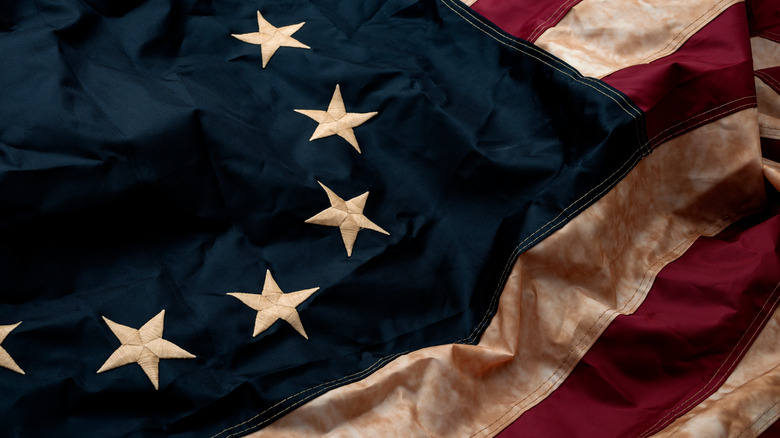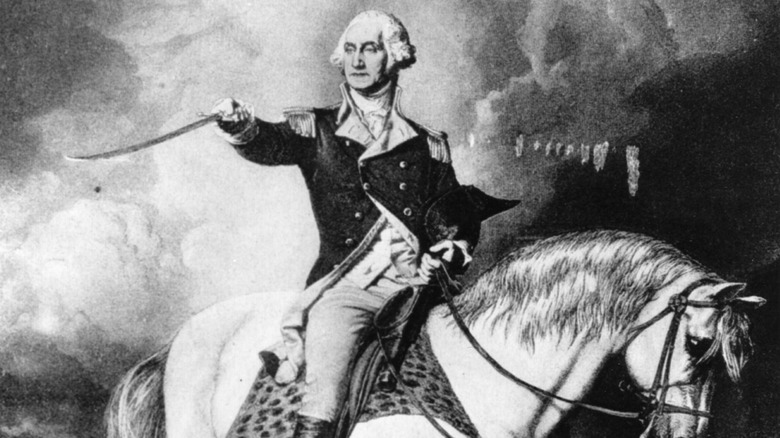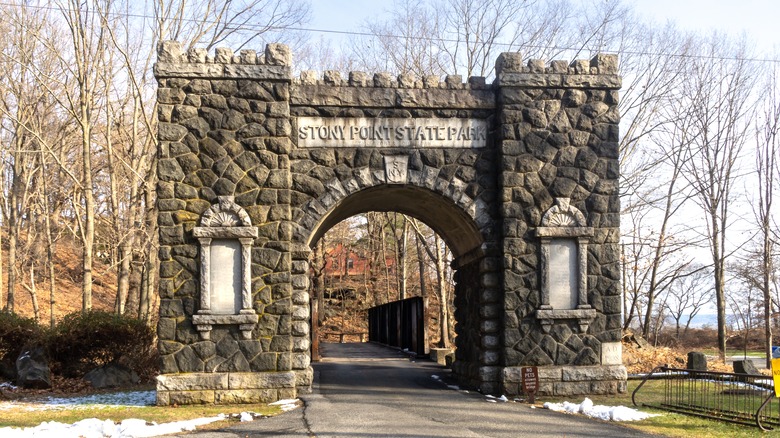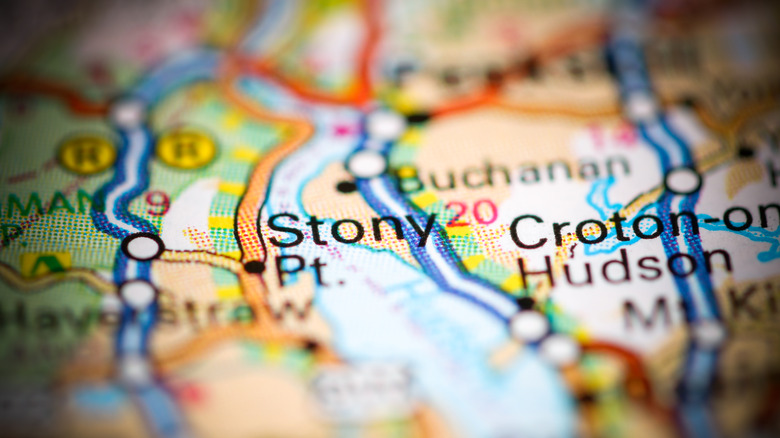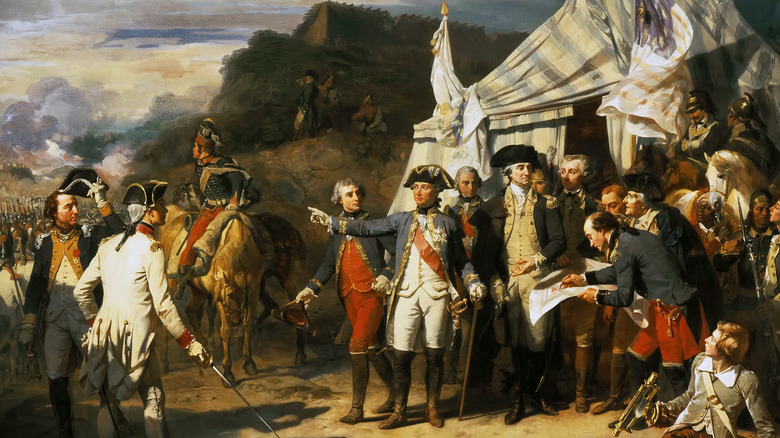The Revolutionary War Battle Strategy That Had Soldiers Behaving In A Very Unusual Way
In early 1779, the American Continental Army was weary after the winter at Valley Forge and the massive defeat at the Battle of Monmouth. The British held New York City, and the Americans were camped across the river in Middlebrook, New Jersey. They fought small skirmishes, but no major battles, because the British were focused on taking major southern cities at the time, including Savannah, Georgia, and parts of the Carolinas. They did, however, want to destroy George Washington's army once and for all, so they hoped to draw him into one final, decisive battle. British general Sir Henry Clinton was ordered to do just that.
Washington didn't take their bait and went forward with his own battle plans instead. The ensuing battle at Stony Point was significant in that it proved the courage and skill of the American army and gave them some badly-needed morale (via the American Battlefield Trust).
Stony Point
Stony Point, New York, was one of two terminals of King's Ferry — the other being Verplank. This ferry crossed at the first narrow part of the Hudson River north of Manhattan, half a mile wide, making it a very important spot. The water was also deep there (via Mount Vernon). Stony Point took its name from a steep, rocky area that rose 150 feet above the river. It was connected to the mainland by a thin strip of land. On either side of this were tidal marshlands.
The spot therefore had natural defenses, but the British had added more, including earthworks, or tall banks of soil, and abatis, or clusters of sharp, tangled branches or trees (via the American Battlefield Trust). Behind the first line of abatis were fleches, areas where guns could be positioned to defend the fortifications. More guns and batteries were in other parts of the fortifications. About 525 British troops were stationed there, and there were around 70 women and children with them, according to Mount Vernon.
Before the battle
Prior to the British building these fortifications, they had taken the spot from the Americans on June 1, 1779. They were hoping to entice George Washington into battle. Their plan was to attack important American holdings on the Hudson River while also attacking areas on the Connecticut coast to drive Washington out of his position at West Point. On May 31, the British landed on both sides of the river at King's Ferry and took Fort Lafayette, at Verplank, from the Americans, who then abandoned Stony Point (via Mount Vernon).
Washington sent most of the Continental Army to defend West Point, but he sent Major Henry Lee (father of Robert E. Lee) to do reconnaissance on what was happening at Stony Point. Later, Washington himself as well as Brigadier General Anthony Wayne also surveyed the area (via Mount Vernon). Wayne wanted revenge for a midnight attack on his troops by the British in 1777, in which around 200 American soldiers had been killed by British bayonets (via the American Battlefield Trust). According to Mount Vernon, he and Washington planned to do the same thing to the British at Stony Point. Wayne commanded about 1,200 Light Infantrymen, elite soldiers hand-picked from other regiments, according to the American Battlefield Trust. They had been trained to fight non-linearly — highly unusual for the time. On the afternoon of July 15, 1779, they moved into position about a mile from Stony Point (via Mount Vernon).
The battle begins
According to Mount Vernon, Wayne's men attacked that night. They were divided into three columns. Wayne, with around 700 men, approached Stony Point from the south, through marshes. The second column, coming from the north, included about 300 men. These two columns carried only fixed bayonets, although some had unloaded muskets. A third column approached the British fortifications head-on with guns, firing to divert the British toward them, away from the main columns (via the American Battlefield Trust).
Wayne's column made their way slowly through the wet terrain, then ran up the slope of Stony Point. The north column was doing the same on their side. The first line of British defense began to fire on them, but then, according to plan, they were distracted by the middle column's fire. The British commander, Lieutenant Colonel Henry Johnson, fell for the trick and took his troops down to face the middle column. He soon realized his mistake when he heard the other American columns advancing behind him (via the American Battlefield Trust).
The battle continued
The British under Johnson went back up the slope to engage with the other Americans. The main two American columns made their way into the fortifications, chopping through the abatis with axes (via the American Battlefield Trust). They fought off the British with only bayonets, also unusual for the time. The British were confused, firing on each other because they couldn't tell who was American and who was British. The Americans, on the other hand, had attached white paper to their hats to be able to identify each other in the dark (via Mount Vernon).
In the melee, Wayne was wounded and instructed his men to carry him to the fort, because he wanted to be at the head of his troops even if he was dying. The wound was shallow, and he survived but gained the nickname "Mad Anthony" for his actions that night (via the American Battlefield Trust). The Americans made into the inner earthworks of the fort, and the British were defeated in 25 minutes. On the American side, 15 died and 83 were wounded, whereas 20 Brits were killed, 74 wounded, and 472 captured (via the American Battlefield Trust).
After the battle
The Battle of Stony Point proved the courage of American troops, and Wayne had his revenge. Two days later, Washington visited Stony Point and determined that his troops wouldn't be able to hold the position against the large British troop now on the way there. He ordered the fortifications to be destroyed and every British person there to be taken prisoner, according to the American Battlefield Trust. Two days later, the British retook the abandoned Stony Point and rebuilt their fortifications, but by October, they had abandoned the area again, too. The humiliation of the British at Stony Point and also at Paulus Hook on the Hudson in August meant that they made no further attempts on American Hudson River holdings (via Mount Vernon).
Washington took note of the success of the tactics used at Stony Point, and two years later he used similar tactics to attack the British at night in the Battle of Yorktown, the last major battle of the Revolutionary War, which secured the American victory (via the American Battlefield Trust).
